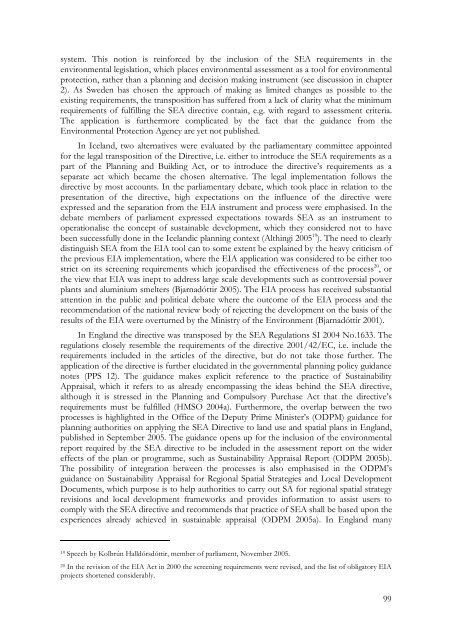SEA IN THE CONTEXT OF LANDTUSE PLANNING
SEA IN THE CONTEXT OF LANDTUSE PLANNING
SEA IN THE CONTEXT OF LANDTUSE PLANNING
You also want an ePaper? Increase the reach of your titles
YUMPU automatically turns print PDFs into web optimized ePapers that Google loves.
system. This notion is reinforced by the inclusion of the <strong>SEA</strong> requirements in theenvironmental legislation, which places environmental assessment as a tool for environmentalprotection, rather than a planning and decision making instrument (see discussion in chapter2). As Sweden has chosen the approach of making as limited changes as possible to theexisting requirements, the transposition has suffered from a lack of clarity what the minimumrequirements of fulfilling the <strong>SEA</strong> directive contain, e.g. with regard to assessment criteria.The application is furthermore complicated by the fact that the guidance from theEnvironmental Protection Agency are yet not published.In Iceland, two alternatives were evaluated by the parliamentary committee appointedfor the legal transposition of the Directive, i.e. either to introduce the <strong>SEA</strong> requirements as apart of the Planning and Building Act, or to introduce the directive’s requirements as aseparate act which became the chosen alternative. The legal implementation follows thedirective by most accounts. In the parliamentary debate, which took place in relation to thepresentation of the directive, high expectations on the influence of the directive wereexpressed and the separation from the EIA instrument and process were emphasised. In thedebate members of parliament expressed expectations towards <strong>SEA</strong> as an instrument tooperationalise the concept of sustainable development, which they considered not to havebeen successfully done in the Icelandic planning context (Althingi 2005 19 ). The need to clearlydistinguish <strong>SEA</strong> from the EIA tool can to some extent be explained by the heavy criticism ofthe previous EIA implementation, where the EIA application was considered to be either toostrict on its screening requirements which jeopardised the effectiveness of the process 20 , orthe view that EIA was inept to address large scale developments such as controversial powerplants and aluminium smelters (Bjarnadóttir 2005). The EIA process has received substantialattention in the public and political debate where the outcome of the EIA process and therecommendation of the national review body of rejecting the development on the basis of theresults of the EIA were overturned by the Ministry of the Environment (Bjarnadóttir 2001).In England the directive was transposed by the <strong>SEA</strong> Regulations SI 2004 No.1633. Theregulations closely resemble the requirements of the directive 2001/42/EC, i.e. include therequirements included in the articles of the directive, but do not take those further. Theapplication of the directive is further elucidated in the governmental planning policy guidancenotes (PPS 12). The guidance makes explicit reference to the practice of SustainabilityAppraisal, which it refers to as already encompassing the ideas behind the <strong>SEA</strong> directive,although it is stressed in the Planning and Compulsory Purchase Act that the directive’srequirements must be fulfilled (HMSO 2004a). Furthermore, the overlap between the twoprocesses is highlighted in the Office of the Deputy Prime Minister’s (ODPM) guidance forplanning authorities on applying the <strong>SEA</strong> Directive to land use and spatial plans in England,published in September 2005. The guidance opens up for the inclusion of the environmentalreport required by the <strong>SEA</strong> directive to be included in the assessment report on the widereffects of the plan or programme, such as Sustainability Appraisal Report (ODPM 2005b).The possibility of integration between the processes is also emphasised in the ODPM’sguidance on Sustainability Appraisal for Regional Spatial Strategies and Local DevelopmentDocuments, which purpose is to help authorities to carry out SA for regional spatial strategyrevisions and local development frameworks and provides information to assist users tocomply with the <strong>SEA</strong> directive and recommends that practice of <strong>SEA</strong> shall be based upon theexperiences already achieved in sustainable appraisal (ODPM 2005a). In England many19 Speech by Kolbrún Halldórsdóttir, member of parliament, November 2005.20 In the revision of the EIA Act in 2000 the screening requirements were revised, and the list of obligatory EIAprojects shortened considerably.99
















